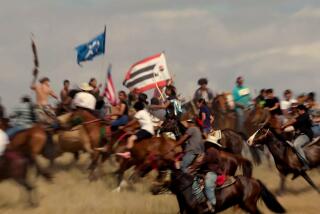Custer Saga’s Other Side
- Share via
Americans have come far in viewing the Battle of the Little Bighorn as something more than just “Custer’s Last Stand.” After all, Lt. Col. George Armstrong Custer and his 7th Calvary were out to massacre the Sioux, the Cheyenne and others who refused to give up their historic hunting ground for the peonage of the white man’s reservation. “Annihilation” was the official term.
Custer’s was one of three U.S. Army units aiming to trap and wipe out the 1,500 Lakota, Cheyenne and Arapaho warriors and their families who still lived in southern Montana in America’s centennial year of 1876.
Custer’s orders were to delay his attack until all three units were ready to engage the Indians. The lieutenant colonel, smarting from career reversals, thought he could whip them himself and become a hero again, perhaps even president. A proverb fits the situation: “Pride goeth before destruction, and an haughty spirit before a fall.”
The rest is sorry and often distorted history, colored by racism. On June 25, the 127th anniversary of the battle, the National Park Service, working with the tribes, will finally present the Indians’ side of the Custer legend with the dedication of a memorial authorized by Congress in 1991.
No longer will the battlefield be dominated by the white monument to Custer and his 262 men on Last Stand Hill. Supt. Darrell Cook says it’s difficult to tell the full story of the battle without a tribute to the Indians. “This memorial will do that and it should generate a lot more questions from visitors,” Cook said. The site, near Crow Agency, Mont., has been a national cemetery since 1879 and a monument since 1946. But until the 1991 law, it was known as Custer Battlefield National Monument. Custer, the pompous blunderer, somehow was lionized for his foolhardy charge into the overwhelming strength of the Indian camp.
The $2-million Indian memorial is in the form of a raised mound northwest of the 7th Cavalry monument. The granite inner walls bear bronze sculptures of “spirit warriors” representing the Lakota (Sioux), Cheyenne and Arapaho tribes. A “spirit gate” looking out toward the Custer monument is marked by two large timber flagpoles. Portions of the walls are reserved for the tribes to inscribe their stories of the battle as told through the generations. Those stories should portray the Plains Indians for what most of them were -- not brutes and vicious killers but proud, religious, family-oriented people who mostly wanted to be left alone.
More to Read
Sign up for The Wild
We’ll help you find the best places to hike, bike and run, as well as the perfect silent spots for meditation and yoga.
You may occasionally receive promotional content from the Los Angeles Times.






